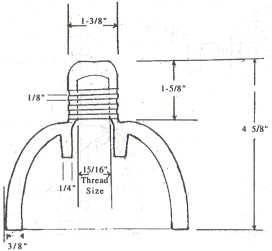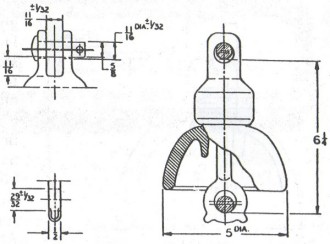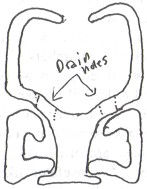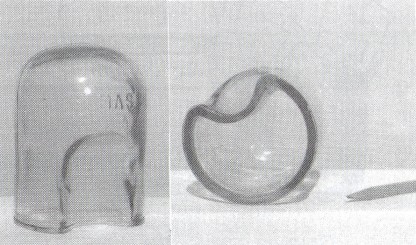Foreign Insulators
by Marilyn Albers
Reprinted from "Crown Jewels of the Wire", August 1994, page 22
FOREIGN "WHATISITS"
In recent weeks I have received several letters from collectors seeking
information on pieces they believe to be insulators. All were manufactured in
countries outside North America, which explains why the letters landed on my
desk. I would like to share two of these with you. The first is from Gary Short
of Chapmansboro, Tennessee, who first wrote to Carol McDougald, our Crown Jewels
Editor, and she in turn forwarded the letter on to me:
"Enclosed is a
picture and a diagram of an insulator I recently acquired. The insulator is
shaped like a school bell, or a big cookie cutter. It is 4-5/8" high, the
base is 5" wide, and the thickness of the skirt glass is 3/8". The
best thread measurement I could get was 15/16". The knob on the top is 1-5/8" high and 1-3/8" thick. It has 3 grooves that are
1/8" wide.
It has a groove on the bottom that has four buttons which are 90 degrees apart.
The buttons are approximately 3/16" long and 1/8" high.
The only
marking on the insulator is '013' on the front skirt. On the inside on the left
there is a '1' and a '3', one on top of the other, and 180 degrees to the right
there is a '3'. The insulator's color is aqua, similar to a coke bottle or a
little darker, and it is glass. There is no doubt -- it is an insulator.
The
origin and use, the manufacturer, and the time of manufacture are questions I
have concerning this insulator. I did not find it in the McDougald's book. A
collector in my area has a foreign manual and it is was not in it. Her husband
seems to think it may be a prototype. If there is a way to find out more about
this insulator, I would certainly like to know how and where. I look forward to
hearing from you regarding this matter."
Unfortunately, Gary's photos were not clear enough to print, but they did
enable me to identify the piece. His diagram was excellent.

I will be happy to give you what information I have concerning the bell
shaped insulator you have found. It was manufactured by a company called
SEDIVER, headquartered in Paris, France. The name is taken from Societe Europeene
d'lsolatueurs en Verre or "European Glass insulator
Association". SEDIVER was established in 1959 by the merger of two French
insulator manufacturers known as L'ELECTRO VERRE and NORD VERRE. Insulators
produced at the SEDIVER plant in St. Yorre were marked EIV, for Europeene
d'lsolatueurs en Verre or "European Glass Insulators". In 1988 this
trademark was changed to SEDIVER. Quoting directly from GLASS INSULATORS FROM
OUTSIDE NORTH AMERICA, SECOND REVISION (1993): "SEDIVER continues to
furnish both communication and power units to a worldwide market according to
international specifications. For overhead transmission lines, the company
exports toughened glass insulators to at least sixty-three countries. SEDIVER's
processes are also applied, under license, in seven countries for local assembly
of insulators. There are manufacturing facilities in three other countries
outside France, and many sales agents all over the world."
Your photo and
drawing indicate that you have the glass portion of a clevis-tongue. type
insulator designed and manufactured by SEDIVER for distribution deadend and
suspension applications. It is made of "toughened glass", a process
developed by SEDIVER in 1945 to give the glass dielectric shells increased
resistance to breakage in shipment, storage, installation and service. Toughened
glass is the material best suited for overhead line insulation, regardless of
voltage. Enclosed is a drawing of an insulator taken from a recent SEDIVER
catalog. It is similar in size and shape to the one you have, except it has a
cap of cast malleable iron and a pin of forged carbon steel. Your insulator
would be considered an incomplete unit without these metal components. This
also explains why it is shorter than the insulator in the drawing. The piece you
have may have been removed from a batch of glass shells headed for an assembly plant. I say
this because if
the insulator had been complete and someone had removed the cap or pin with some
kind of solvent, visible signs of tampering would be noticeable on the crown
and in the pin hole.

Clevis-Tongue Type
Cat. No.: CT-4R2M
Today, SEDIVER offers several other suspension insulators varying in size and
design, with selection by the user, dependent on application and environmental
conditions. Present day units are made of either clear or light green glass, as
these colors seem to blend best with all surroundings. The aqua color of your
insulator indicates that it is a bit older. Suspension insulators are intended
to be used in groups or long strings, rather than singly. They are connected
together by "cap and pin" i.e. the cap of one insulator fits around
and secures the pin of the one above it, etc. Below is a photo showing a
string of suspension insulators I have hanging in a tree, just for fun. The
shells are the same size as the one you have, but mine are made of clear glass.
The iron caps are marked as shown at the right:
I asked N. R. "Woody" Woodward for help in deciphering all these
numbers. He says the "50" indicates a wet flashover voltage of 50,000
KV. "SED 86" means the insulator was made by SEDIVER in 1986.
"5000 TEST" is the maximum mechanical load one insulator can support,
and the number "3101" may identify a particular run of insulators, but
he does not have the precise information for decoding these particular numbers.
The three grooves on the crown of your glass shell were designed to hold the
cemented iron cap securely in place and this cap probably would have been marked
EIV. Woody thinks that the numbers on the glass are mold and or date codes and
that the four small buttons on the base are just part of the mold. They would
serve no special purpose. An insulator like yours, even if it were a complete
unit, would probably not bring more than $8 to $10 at an insulator show. These
pieces are interesting but they are of current production and quite easily
obtained. One can see them on power lines in just about every part of the world.
Hope I haven't taken the wind out of your sails, Gary. It is still a beautiful
piece of glass! Thanks for writing.
The next letter comes from Michael Neese of Caro, Michigan. This is the real
head scratcher!:
"I've been collecting American glass insulators for a number of years
now and have only recently been purchasing porcelain pieces (of which I have
little knowledge), but have never laid a finger on any insulators from outside
North America, at least not until today. My grandfather, knowing that I collect
insulators, picked up an odd porcelain piece and just now gave it to me after
coming back from one of his numerous antiquing treks. This piece is the strangest thing I've ever seen, but of course I'm uneducated when it
comes to foreign pieces. I figured I could send you a letter and perhaps you
could help me identify this piece. Enclosed are drawings and dimensions".
Michael's sketch of the piece, showing it to be 3" in height and 2-7/8" across the base, was one of several he made. Due to space
limitations, not all are included here.

Your Bing & Grondahl 'insulator' caused quite a stir at our recent Lone
Star Insulator Club meeting. There were several knowledgeable collectors there
that night, including Elton Gish and N. R Woodward. Many wild guesses as to its
use were thrown around, ranging from part of a gigantic coffee maker to some
sort of plumbing fixture! All of us were in agreement that it is not an
insulator, nor was it intended for either telecommunication or power use.
Nevertheless, we were impressed by the line quality of the navy blue glaze and
consider this a beautiful piece of porcelain, whatever its function in the
scheme of things.
No one could figure out how this thing was made, since it
consists of two separate pieces, which can be turned freely and independently of
each other, yet cannot be taken apart. As for wires coming together and going
down through the hole at the top, this would indeed be possible, but there is no
place for them to come out again! So that option was ruled out. It is our
collective opinion (pun intended) that this piece was meant to be used as a drain for liquid of some sort, but we do not know in
what capacity.
Bing & Grondahl of Copenhagen, Denmark did indeed make
insulators at one time (I have one dated as early as 1918), but I don't know if
they are still a part of the company's product line. I suspect not, as very few
have been located. Those in captivity appear to be quite old. However, the
factory is still making fine porcelain dinnerware, because I'm still seeing it
in department stores. Supposedly they produce articles of stoneware and
earthenware as well, but my source of information does not specify what types.
Insulators are marked simply "B & G", while dinnerware is stamped
with the more complete trademark found on the piece you have.
Thanks for getting
in touch, Michael, and I'll sure let you know if any of our readers can come up
with an answer. I'm dying to know, myself. Hopefully, you won't have to settle
for using it as a toothbrush holder.
- - - - - - - - - - -
I received a third inquiry by telephone. This came from Earl Ross of Bingham
Farms, Michigan. Earl is a not an insulator collector, but he has had this
strange looking glass piece ever since he cleaned out his parents' attic in
1981. He is not sure how long they had it or where it came from, but he'd like
to know if it is an insulator. If it is not, he hopes at least to learn its age,
its intended use and perhaps its value. Earl agreed to send it to me for the
photos you see below. This would-be "insulator" is hollow, and the
straw colored glass of which it is made appears to be of fine quality. It is
4" in height and measures 3" across the widest part of the base.
Embossed on one half-mold are the words "THOMAS'S HALIFAX" and on the opposite half-mold "MADE IN
ENGLAND". There is no hint of a date.

Our local Lone Star Insulator Club
had its monthly meeting not long after you sent the glass, and I took it along
as a "show 'n tell" item, hoping someone would recognize what it was.
Two of our members, N. R. Woodward and Elton Gish, are exceptionally
knowledgeable about all sorts of insulators made of porcelain and glass, and
neither they nor anyone else thought it could be an insulator used for
telecommunication or power. None of us have seen anything exactly like it before
and we are all mystified over this piece. The consensus of opinion is that it is
either a reflective cover for a light, such as a landing light at an airport, or
some sort of conduit or holder for electrical wires, in which case the
indentation on the side could be for securing a metal clamp to hold the glass in
place.
If anyone can shed any light on either the "B & G"
porcelain or the "THOMAS'S HALIFAX" glass piece, please write and let
us know. Michael Neese and Earl Ross will be two happy campers!
| 